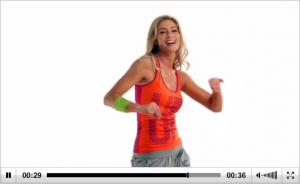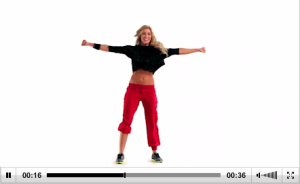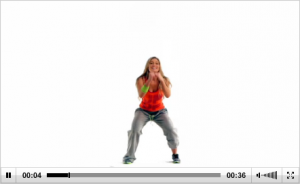The E-commerce Product Video That Increases Revenue Per Visit
Which video recipe will make your cash register ring more often and more loudly? It was the end of a 12-hour video shoot. We had heard the same song over and over, about 200 times. Our model had just finished dancing in 24 outfits, having completing over 150 identically executed squats as part of her routine. […]
Which video recipe will make your cash register ring more often and more loudly?
It was the end of a 12-hour video shoot. We had heard the same song over and over, about 200 times. Our model had just finished dancing in 24 outfits, having completing over 150 identically executed squats as part of her routine.
The rest of us were just tired from thinking about that.
From one day of shooting, we would generate 120 different product videos to be tested on an e-commerce website. It was fully expected that these videos would provide a boost for the major fitness apparel manufacturer’s online store.



As is so often the case, things didn’t turn out as expected.
Search traffic is expensive, whether organic or PPC. On a site that already employed Bazaarvoice ratings and reviews, numerous product photos and a favorable product page layout, we felt a product video was the missing piece, and that it would convert more of these expensive searchers to buyers .
Benefits Of Product Video
The primary visitor question we wanted to answer with video was, “How will these products look on me in a fitness class?” Video seemed to be the answer. For our personas, questions about sizing (“Does this run small?”) and quality were addressed in the ratings and reviews, and in Facebook comments.
Only video could answer questions about how the products look in motion.
Similar questions arise in industries such as eyewear, where generous return policies are required to overcome the objection, “How will it look on me?”
Product video has gotten a lot of good press in the conversion world these days. Zappos reported a conversion lift of between 6% and 30% when it added videos to its product pages. They were so impressed that they opened several studios and put 45 people to work creating videos for the thousands of products on the site.
Other sites reporting positive results from product videos are StacksAndStacks.com, Ice.com, and OnlineShoes.com.
The Test
The brand we were optimizing for felt that energy was a key ingredient in their message. They wanted product videos that captured it. That meant music and movement.
Within these guidelines, there were thousands of ways to design the videos. We wanted to understand what length and shot style would generate the most sales. Once we understood the best-performing recipe, we could invest in rolling that style out to all of the products.
There were two hypotheses we wanted to test first:
- Video length that would impact revenue
- If inclusion of a wide shot showing the product as part of an ensemble would increase revenue
We chose 24 products with the traffic to complete a video split test in a reasonable timeframe. We defined three video lengths of approximately 8 seconds, 15 seconds and 30 seconds. We created two additional videos that included a wide shot of the model and her outfit.
This gave us a total of five videos over 24 products. In the end, we generated 120 videos from one shoot day.
A simple video icon was added to the product pages along with the existing still photos. The video opened in a pop-over “lightbox” window.
Controlling Other Variables
The challenge then became controlling for other variables, or more specifically, eliminating the other variables’ impact on the results. All other elements of the video had to be exactly the same.
We used the same model for all videos. We used the same music for all shots. Our model was choreographed in exquisite detail to ensure her movements didn’t influence results.
If we didn’t do this, we would really have never known how song choice, model choice or moves had impacted the searchers coming to the site.
We chose a generic white background to make the products “pop” and to keep our test simple.
The other variable that can significantly affect video (and any page for that matter) is load time. We selected a reliable video hosting service with a good reputation to deliver the videos reliably.
Within six weeks, we had planned, shot and rolled out the test videos on specific products. Adobe’s Test and Target software provided the testing platform.
The Results
After several weeks of testing, it became apparent that, overall, video was decreasing revenue per visit. Uh oh…
Our first reaction was, “Well, at least we didn’t invest in video for all of the products.”
But, there was more to the story.
The searcher persona matters. Are they new visitors or returning? Are they instructors or consumers? How did they find the site?
Test and Target offers a feature that allowed us to look at results on a segment-by-segment basis. Being scientists and geeks, we created 198 different segments to watch and found some very interesting results.
Different kinds of visitors like different video recipes.
Visitors who identified themselves as fitness instructors didn’t like video so much, but regular consumers did.
The type of browser used had consistent and significant impact on revenue per visit.
Organic and PPC traffic from Google responded very positively to the right video. This creates a virtuous cycle in which video decreases bounce rates, which makes Google believe your page is worthy of high rankings. Since video also puts more money in your pocket, it can be an true accelerator for your online business.
In the process, we discovered some unexpected segments. For example, new visitors wanted to see the whole model when shopping for bottoms (pants and shorts). For those shopping for tops (shirts and warm-ups) the wide shot was unnecessary. For most segments, video increased revenue for bottoms more than tops. This may be due to the fact that bottoms are more expensive than tops, so there is more resistance to purchase.
Video is getting these price-conscious visitors across the finish line.
In many cases, gains were significant. For search traffic specifically, video increased RPV across the board by between 25% and 100%, depending on the segment. Overall, choosing six videos and putting them in front of the right visitor gave us RPV increases approaching 50%. That’s a significant increase month after month.
Conversion Rate Vs. Revenue Per Visit
In many cases, conversion rates actually dropped when video was added to the page, but were more than made up for by increases in average order value, a distinction that would have been missed if we weren’t measuring revenue per visit.
Conversion rate measures the number of transactions generated by visiting searchers. Revenue per visit measures the revenue generated by the test product divided by the number of visitors to the product page. This combines conversion rate with average order value (AOV). This is the preferred statistic for the online store equation.
We could probably double your conversion rate by cutting all of your prices in half. However, this would likely have a negative impact on your business by reducing the overall revenue generated. Watching revenue per visit ensures that we’re increasing conversion rate without impacting revenue.
What Should You Do?
For online stores, video is a great bet for increasing revenue. Video can easily pay for itself, but if it is not produced and targeted properly, it can have a negative impact on your business. Every audience is different, and testing is the key.
Do your own tests of video before investing in a catalog-wide video strategy. If you invest in the testing tools that give you the insights you need, be sure to invest in the people who will intelligently pull the levers and dial the knobs. This will be a significant competitive advantage.
Start with specific hypotheses, and control the ancillary variables to confidently find the video recipes that make your cash register ring more often and more loudly.
We’ve just completed eye-tracking tests on three kinds of video: talking head style, webinar-style and hand-drawn video. I will be presenting the results at Conversion Conference East 2012. You should be there.
Contributing authors are invited to create content for Search Engine Land and are chosen for their expertise and contribution to the search community. Our contributors work under the oversight of the editorial staff and contributions are checked for quality and relevance to our readers. The opinions they express are their own.
Related stories
New on Search Engine Land